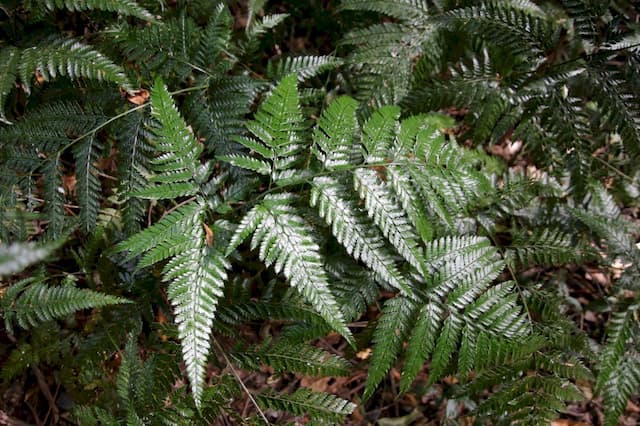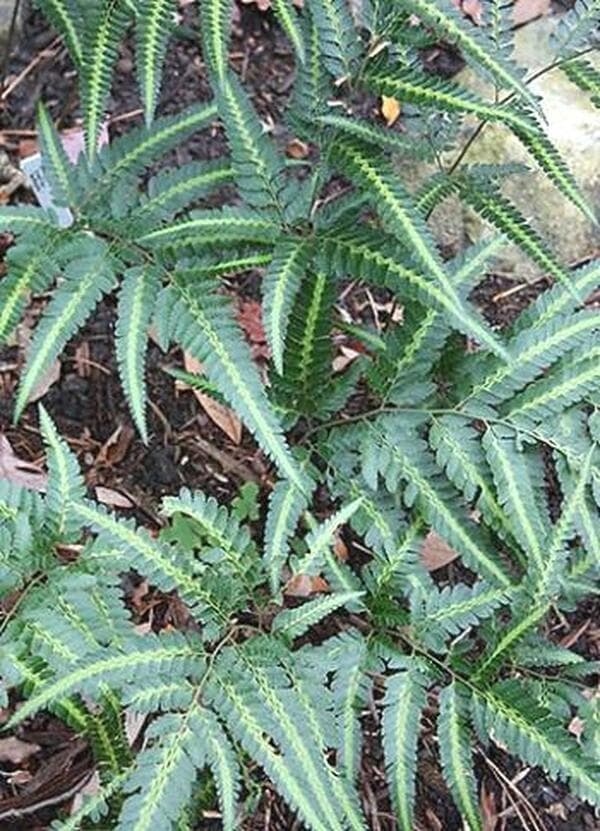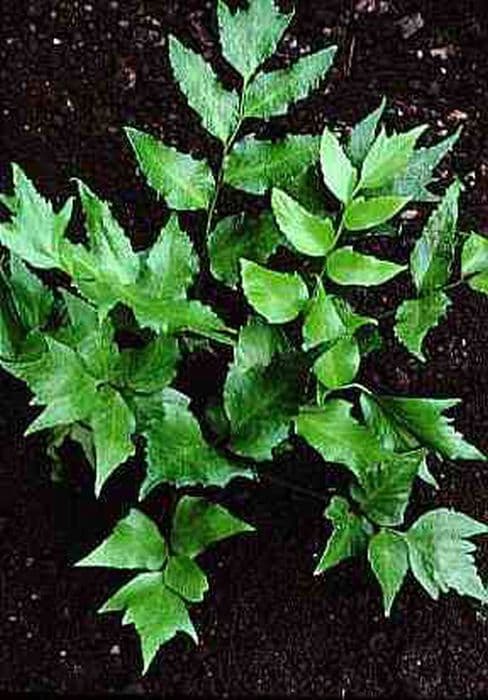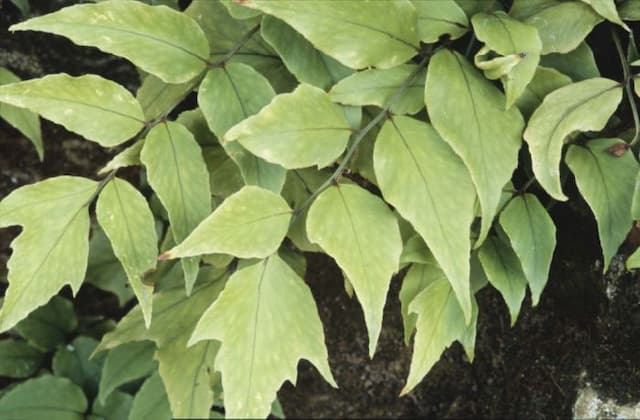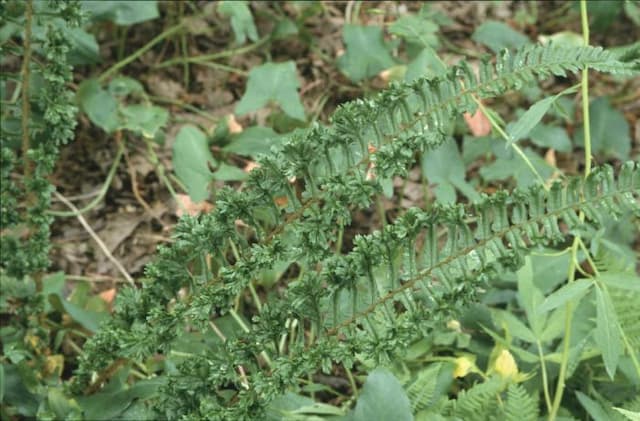Korean Rock Fern Polystichum tsussimense

ABOUT
Known commonly as the Korean rock fern, this plant boasts dark green, glossy foliage that gives it a luscious appearance. Its leaves, referred to as fronds, are triangular and spread outwards in a symmetrical and feather-like fashion. Each frond is composed of numerous small leaflets which are neatly arranged on either side of a central stalk, creating a highly textured look. The edges of the leaflets are slightly toothed, offering a delicate and intricate aesthetic. These fronds emerge from a central point, forming a circular cluster that gives the plant its dense and compact look. The fern has a robust quality, with the fronds being quite sturdy and stiff to the touch, suggesting that it's well adapted to survive in tough growing conditions. The underside of the fronds is where the reproductive spores are located, typically forming in neat rows or dots. These spore cases add another layer of detail to the fern's appearance, often having a contrasting color which may vary from the green of the fronds. Throughout the year, the vibrant green shades of the Korean rock fern add a touch of evergreen beauty to the environments in which it thrives, often used in shade gardens or as ground cover due to this attractive foliage. Being a fern, this plant does not have flowers or seeds, and its visual interest lies entirely within its textured, green leaves.
About this plant
 Names
NamesFamily
Dryopteridaceae
Synonyms
Korean Rock Fern, Tsus-sim Fern
Common names
Aspidium tsus-simense, Polystichum tsus-simense, Polystichum bicknellii, Polystichum tsus-simensis.
 Toxicity
ToxicityTo humans
The Korean rock fern (Polystichum tsussimense) is generally not considered toxic to humans. There is no significant information suggesting that this fern poses a risk if touched or ingested. However, as with any plant, individual allergies or sensitivities can occur, and it is always wise to avoid eating plants that are not commonly recognized as food, as they can cause gastrointestinal upset or other issues in sensitive individuals.
To pets
The Korean rock fern (Polystichum tsussimense) is not known to be toxic to pets either. It appears to be safe for cats and dogs, as there is no evidence of this fern causing poisoning in these animals. Despite this, it's still a good practice to prevent pets from ingesting plants, as they can potentially cause intestinal discomfort or allergic reactions in some pets.
 Characteristics
CharacteristicsLife cycle
Perennials
Foliage type
Evergreen
Color of leaves
Green
Height
1-2 feet (30-60 cm)
Spread
1-2 feet (30-60 cm)
Plant type
Fern
Hardiness zones
5-9
Native area
Asia
Benefits
 General Benefits
General Benefits- Landscaping: Polystichum tsussimense, commonly known as Korean rock fern, is often used in shaded or woodland gardens for its aesthetic appeal.
- Drought Tolerance: Once established, it can tolerate periods of dryness, though it prefers moist conditions.
- Low Maintenance: Korean rock fern requires minimal care, making it a practical choice for busy gardeners or those seeking low-maintenance landscapes.
- Cold Resistance: It's hardy and can withstand cold temperatures, which makes it suitable for a range of climates.
- Erosion Control: The fern can help in stabilizing soil and preventing erosion on slopes or in areas with loose soil.
- Habitat: Provides shelter and habitat for various small wildlife and insects.
- Evergreen: Being evergreen, it contributes to year-round greenery and visual interest in gardens or natural settings.
 Medical Properties
Medical Properties- This plant is not used for medical purposes.
 Air-purifying Qualities
Air-purifying QualitiesThis plant is not specifically known for air purifying qualities.
 Other Uses
Other Uses- Interior decoration: Korean rock ferns can be used in floral arrangements or terrariums to add greenery and a touch of nature indoors.
- Natural dye: The fronds of the Korean rock fern can be used to produce a green dye for textiles.
- Educational resource: This plant may be used in botany education to help students learn about fern reproduction and spore dispersal.
- Ground cover: In landscaping, Korean rock ferns can serve as a low-maintenance ground cover in shaded areas.
- Livestock bedding: Dried ferns, including Korean rock ferns, can potentially be used as bedding for small livestock due to their absorbent nature.
- Garden art: Live or dried Korean rock fern fronds can be incorporated into garden art or sculptures for a natural aesthetic.
- Culinary decoration: While not edible, the fronds can be used as an ornamental garnish for plating in high-end culinary presentations.
- Photography subjects: With their intricate frond patterns, they make for interesting subjects for macro and nature photography.
- Biodegradable mulch: Decomposing Korean rock ferns can provide a natural mulch that enriches soil with organic matter.
- Botanical illustrations: Artists may use Korean rock ferns as subjects for botanical illustrations, contributing to scientific and artistic works.
Interesting Facts
 Feng Shui
Feng ShuiThe plant known as Korean Rock Fern is not used in Feng Shui practice.
 Zodiac Sign Compitability
Zodiac Sign CompitabilityThe Korean Rock Fern is not used in astrology practice.
 Plant Symbolism
Plant Symbolism- Endurance: As a fern, Polystichum tsussimense, commonly known as the Korean Rock Fern, symbolizes endurance due to its ability to thrive in rocky terrains and adverse conditions.
- Strength and Sturdiness: The robust nature of this fern often represents strength and the ability to withstand challenges.
- Protections: Ferns are often thought to offer shelter and protection in their natural habitats, making them emblematic of safeguarding and security.
- Eternal Youth: Ferns are ancient plants with a prehistoric presence, and thus, the Korean Rock Fern can symbolize longevity and the everlasting youth of nature.
- Secret Bond of Love: In some cultures, ferns carry a notion of secretiveness due to their discreet flowerless reproduction, and this fern can be a symbol of a private, inward love that is not outwardly displayed.
 Water
WaterKorean rock fern should be watered thoroughly, allowing the water to soak in rather than just wetting the surface – strive to moisten the soil to a depth of about an inch. Typically, watering once a week is sufficient, but this may vary with room temperature and humidity. The goal is to keep the soil evenly moist without waterlogging, as stagnant water can lead to root rot. During the drier winter months, watering frequency should be reduced to avoid overwatering as the plant's growth slows down. Depending on the size of the pot, starting with about 8-16 ounces of water weekly is a good rule of thumb, adjusting as needed for environmental conditions.
 Light
LightKorean rock fern thrives best in moderate, indirect light conditions. It should be placed in a location where it can receive bright but diffused light, such as near a north-facing window or a few feet away from an east or west-facing window. Direct sunlight can scorch the fronds, so avoid placing this fern in direct afternoon sun.
 Temperature
TemperatureKorean rock fern prefers cooler temperatures and will thrive when kept in an environment that is consistently between 60 and 75 degrees Fahrenheit. The minimum temperature should not drop below 50 degrees Fahrenheit, as cold drafts can damage the plant. These ferns are not tolerant of extreme heat, so it is best to keep them away from heat sources such as radiators or hot air vents.
 Pruning
PruningPruning Korean rock fern is usually done to remove dead or damaged fronds and to maintain the plant's tidy appearance. It is best to prune in the spring before new growth begins. Use clean, sharp scissors or pruning shears to cut the fronds at the base, being careful not to damage the new emerging fiddleheads. Pruning can be done annually or as needed throughout the year to remove occasional brown fronds.
 Cleaning
CleaningAs needed
 Soil
SoilThe Korean Rock Fern thrives in well-draining soil with rich organic matter. The ideal pH range for this plant is slightly acidic to neutral, between 6.0 and 7.5. A mix containing peat, compost, and perlite or pumice would provide a suitable growing medium for this fern.
 Repotting
RepottingKorean Rock Fern typically does not require frequent repotting and should be repotted every 2-3 years. Repotting is best done in the spring, using a similar soil mix that supports good drainage and moisture retention.
 Humidity & Misting
Humidity & MistingKorean Rock Fern prefers moderate to high humidity levels, ideally between 60-80%. If the indoor air is too dry, using a humidifier or placing the fern's pot on a tray of moistened pebbles can help maintain suitable humidity levels.
 Suitable locations
Suitable locationsIndoor
Place in bright, indirect light and keep soil moist.
Outdoor
Plant in partial shade, water regularly, protect from wind.
Hardiness zone
5-8 USDA
 Life cycle
Life cyclePolystichum tsussimense, commonly known as Korean rock fern, begins its life cycle as a spore, which germinates to form a small, heart-shaped gametophyte (prothallus). The gametophyte, through sexual reproduction, gives rise to the sporophyte stage when sperm from the male structures fertilize the eggs in the female structures. Upon successful fertilization, the embryonic sporophyte emerges, gradually developing roots, a shoot, and fronds as it becomes an independent plant. The young fern grows until it reaches maturity, at which point it develops sori on the undersides of its fronds. These sori contain sporangia that produce spores by meiosis, completing the cycle when the spores are dispersed by wind to begin the process anew. The mature Korean rock fern can live for several years, producing spores annually during its reproductive season.
 Propogation
PropogationPropogation time
Spring-summer
Propogation: The Korean Rock Fern (Polystichum tsus-simense) can be propagated by division, which is the most popular method for this plant. This is typically done in the early spring just before new growth starts. Carefully dig up the fern, ensuring a good section of the roots and crowns are included. Using a sharp knife, divide the crown into sections, each with at least one frond and a portion of root. Replant the divisions at the same depth they were growing originally, spacing them about 12 to 18 inches (30 to 45 centimeters) apart to allow for growth. Water these new plantings well to ensure proper establishment. This method allows gardeners to expand their collection of Korean Rock Ferns or to share with others.
